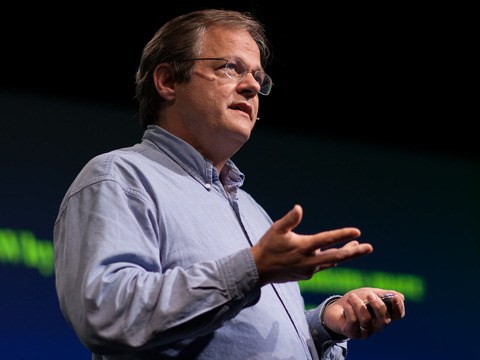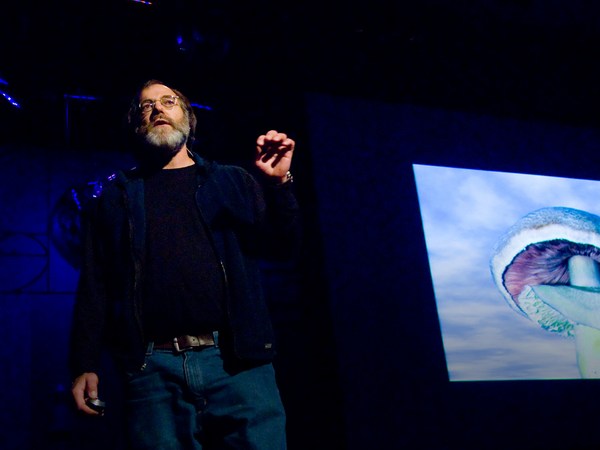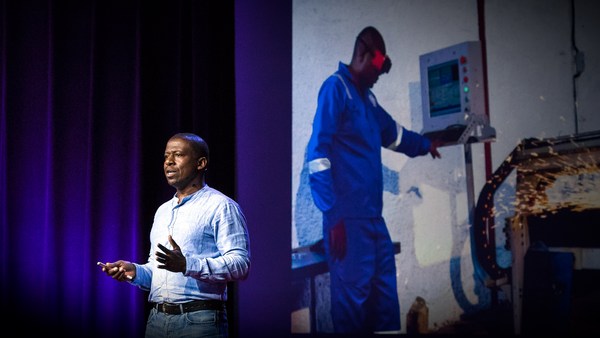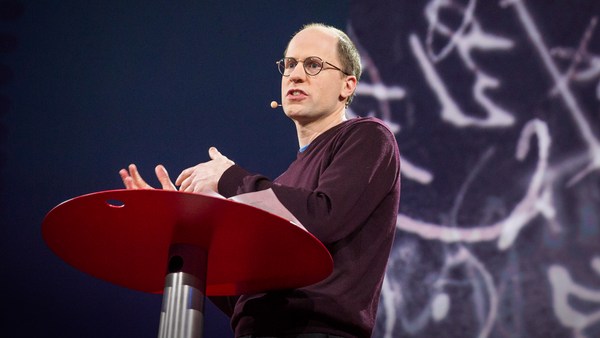How many of you have seen the Alfred Hitchcock film "The Birds"? Any of you get really freaked out by that? You might want to leave now.
(Laughter)
So this is a vending machine for crows. Over the past few days, many of you have been asking, "How did you come to this? How did you get started doing this?" It started, as with many great ideas, or many ideas you can't get rid of, anyway, at a cocktail party. About 10 years ago, I was at a cocktail party with a friend of mine. We were sitting there, and he was complaining about the crows that were all over his yard and making a big mess. And he was telling me we ought to eradicate these things, kill them, because they're making a mess. I said that was stupid, maybe we should just train them to do something useful. And he said that was impossible.
And I'm sure I'm in good company in finding that tremendously annoying, when someone tells you it's impossible. So I spent the next 10 years reading about crows in my spare time.
(Laughter)
And after 10 years of this, my wife said, "You've got to do this thing you've been talking about, and build the vending machine." So I did. But part of the reason I found this interesting is, I started noticing that we're very aware of all the species that are going extinct on the planet as a result of human habitation expansion, and no one seems to be paying attention to all the species that are actually living; they're surviving. And I'm talking specifically about synanthropic species, which have adapted specifically for human ecologies, species like rats and cockroaches and crows.
And as I started looking at them, I was finding that they had hyper-adapted. They'd become extremely adept at living with us. And in return, we just tried to kill them all the time.
(Laughter)
And in doing so, we were breeding them for parasitism. We were giving them all sorts of reasons to adapt new ways. So, for example, rats are incredibly responsive breeders. And cockroaches, as anyone who's tried to get rid of them knows, have become really immune to the poisons that we're using. So I thought, let's build something that's mutually beneficial; something that we can both benefit from, and find some way to make a new relationship with these species. So I built the vending machine.
But the story of the vending machine is a little more interesting if you know more about crows. It turns out, crows aren't just surviving with human beings; they're actually thriving. They're found everywhere on the planet except for the Arctic and the southern tip of South America. And in all that area, they're only rarely found breeding more than five kilometers away from human beings. So we may not think about them, but they're always around. And not surprisingly, given the human population growth, more than half of the human population is living in cities now. And out of those, nine-tenths of the human growth population is occurring in cities. We're seeing a population boom with crows. So bird counts are indicating that we might be seeing up to exponential growth in their numbers. So that's no great surprise.
But what was really interesting to me was to find out that the birds were adapting in a pretty unusual way. And I'll give you an example of that. This is Betty. She's a New Caledonian crow. And these crows use sticks in the wild to get insects and whatnot out of pieces of wood. Here, she's trying to get a piece of meat out of a tube. But the researchers had a problem. They messed up and left just a stick of wire in there. And she hadn't had the opportunity to do this before. You see, it wasn't working very well. So she adapted.
Now, this is completely unprompted; she had never seen this done before. No one taught her to bend this into a hook or had shown her how it could happen. But she did it all on her own. So keep in mind -- she's never seen this done.
(Laughter)
Right.
(Laughter)
Yeah. All right.
(Applause)
So that's the part where the researchers freak out.
(Laughter)
It turns out, we've been finding more and more that crows are really intelligent. Their brains are in the same proportion as chimpanzee brains are. There's all kinds of anecdotes for the different kinds of intelligence they have. For example, in Sweden, crows will wait for fishermen to drop lines through holes in the ice. And when the fishermen move off, the crows fly down, reel up the lines, and eat the fish or the bait. It's pretty annoying for the fishermen.
On an entirely different tack, at University of Washington a few years ago, they were doing an experiment where they captured some crows on campus. Some students went out, netted some crows, brought them in, weighed and measured them, and let them back out again. And they were entertained to discover that for the rest of the week, whenever these particular students walked around campus, these crows would caw at them and run around, and make their life kind of miserable.
(Laughter)
They were significantly less entertained when this went on for the next week. And the next month. And after summer break. Until they finally graduated and left campus, and -- glad to get away, I'm sure -- came back sometime later, and found the crows still remembered them.
(Laughter)
So, the moral being: don't piss off crows. So now, students at the University of Washington that are studying these crows, do so with a giant wig and a big mask.
(Laughter)
It's fairly interesting.
(Laughter)
So we know these crows are really smart, but the more I dug into this, the more I found that they actually have an even more significant adaptation.
Video: Crows have become highly skilled at making a living in these new urban environments. In this Japanese city, they have devised a way of eating a food that normally they can't manage: drop it among the traffic. The problem now is collecting the bits, without getting run over. Wait for the light to stop the traffic. Then, collect your cracked nut in safety.
(Laughter)
(Applause)
Joshua Klein: Yeah, pretty interesting. What's significant about this isn't that crows are using cars to crack nuts. In fact, that's old hat for crows. This happened about 10 years ago in a place called Sendai City, at a driving school in the suburbs of Tokyo. And since that time, all the crows in the neighborhood are picking up this behavior. Now every crow within five kilometers is standing by a sidewalk, waiting to collect its lunch.
So they're learning from each other. And research bears this out. Parents seem to be teaching their young. They learn from their peers, they learn from their enemies. If I have a little extra time, I'll tell you about a case of crow infidelity that illustrates that nicely. The point being, they've developed cultural adaptation. And as we heard yesterday, that's the Pandora's box that's getting human beings in trouble, and we're starting to see it with them. They're able to very quickly and very flexibly adapt to new challenges and new resources in their environment, which is really useful if you live in a city.
So we know that there's lots of crows. We found out they're really smart and they can teach each other. When all this became clear, I realized the only obvious thing to do is build a vending machine. So that's what we did. This is a vending machine for crows. And it uses Skinnerian training to shape their behavior over four stages. It's pretty simple. Basically, what happens is that we put this out in a field or someplace where there's lots of crows. We put coins and peanuts all around the base of the machine. Crows eventually come by, eat the peanuts, and get used to the machine being there. Eventually, they eat all the peanuts. Then they see peanuts here on the feeder tray, and hop up and help themselves. Then they leave, the machine spits up more coins and peanuts, and life is dandy if you're a crow -- you can come back anytime and get yourself a peanut.
So when they get really used to that, we move on to the crows coming back. Now they're used to the sound of the machine; they keep coming back and digging out peanuts from the pile of coins that's there. When they get really happy about this, we stymie them.
We move to the third stage, where we only give them a coin. Now, like most of us who have gotten used to a good thing, this really pisses them off. So they do what they do in nature when they're looking for something: sweep things out of the way with their beak. They do that here, and that knocks the coins down the slot. When that happens, they get a peanut. This goes on for some time. The crows learn that all they have to do is show up, wait for the coin to come out, put it in the slot, then get their peanut.
When they're good and comfortable with that, we move to the final stage, where they show up and nothing happens. This is where we see the difference between crows and other animals. Squirrels, for example, would show up, look for the peanut, go away. Come back, look for the peanut, go away. They do this maybe half a dozen times before they get bored, and then they go off and play in traffic.
Crows, on the other hand, show up and they try and figure it out. They know this machine has been messing with them through three different stages of behavior.
(Laughter)
They figure there must be more to it. So they poke at it and peck at it. And eventually some crow gets a bright idea: "Hey, there's lots of coins lying around from the first stage, hops down, picks it up, drops it in the slot, and we're off to the races. That crow enjoys a temporary monopoly on peanuts, until his friends figure out how to do it, and then there we go.
So, what's significant about this to me isn't that we can train crows to pick up peanuts. Mind you, there's 216 million dollars' worth of change lost every year, but I'm not sure I can depend on that ROI from crows.
(Laughter)
Instead, I think we should look a little bit larger. I think crows can be trained to do other things. For example, why not train them to pick up garbage after stadium events? Or find expensive components from discarded electronics? Or maybe do search and rescue? The main point of all this for me is, we can find mutually beneficial systems for these species. We can find ways to interact with these other species that doesn't involve exterminating them, but involves finding an equilibrium with them that's a useful balance.
Thanks very much.
(Applause)





